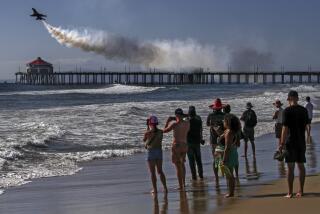Air Show Loyalists Hoping for ’97 Encore
- Share via
EL TORO MARINE BASE — They came as they have year after year, thousands of loyal spectators equipped with big-brimmed hats and super-protective sunscreen, ready to cheer and applaud the feats of world-renowned pilots and high-tech jets.
But when the last Blue Angels jet touched down Sunday afternoon, signaling the end of the 46th El Toro Air Show, some fans wondered aloud just how much longer this air extravaganza will survive.
Even the Marines are making no promises, since the El Toro Marine Corps Air Station is due to close by 1999, leaving the show without a home. While planning has already begun for next year’s event, definite word is not expected until late summer whether that show will go on.
“What they should do is have everyone here write a letter to their congressman,” said air-show loyalist Andrew Sincosky, 62, of West Covina, as he and three friends awaited the reverberating arrival of the U.S. Navy’s fabled Blue Angels.
Amid the uncertainty, more than 1.7 million people attended the air show during its three-day run, including more than 800,000 on Sunday, Marine spokesmen reported.
As temperatures soared and the sun beat down, they kept their eyes trained on the feats above them--the Red Baron Stearman Squadron of barnstorming-type biplanes, Sean Tucker’s dizzying aerial somersaults. They fervently applauded the Marines’ dramatic air-and-ground display, with helicopters whirring above surrealistic bursts of smoke and flames.
“It’s sort of deja vu,” said John App, 57, of Laguna Hills, who flew more than 100 helicopter missions in Vietnam in 1966-67 and is former president of the Vietnam Combat Pilots’ Assn.
“It kind of brings back memories, especially the sounds,” added ex-Marine Daniel Cartagena, 64, of Long Beach, who served in Korea as a machine-gunner.
One of the show’s key players was John L. Goldfluss, who worked away from the crowd in a control area, a Federal Aviation Administration hat on his head. The FAA official served as air-show coordinator and worked with about 10 FAA safety inspectors to ensure the safety of spectators and fliers. Planning began last October for the El Toro show.
“A show this size,” said Goldfluss, motioning at the crammed grandstands, “is not a small undertaking.”
On Sunday afternoon, Goldfluss had to deal with what might seem a unlikely problem for an air show. He spotted golfers on a course inside the safety zone that had to be cleared during jet aeronautic feats. The golfers must go, he said, or he would hold the Blue Angels. The course was cleared forthwith.
But the famous blue-sided jets’ show was later delayed about 10 minutes by a series of unrelated events. One pilot grew ill, and then debris forced the jets to move to another runway, a Marine spokesman said. And after a caution light went off in an airborne jet, the pilot made a precautionary landing and switched to another aircraft.
Early in the day, a spectator, 52-year-old Arne M. Vanbilliard of Orange, was taken by ambulance to Irvine Medical Center, where he was pronounced dead. His daughter, who had accompanied him to the show, reported that he had been experiencing chest pains, according to a statement issued by the air station.
More to Read
Sign up for Essential California
The most important California stories and recommendations in your inbox every morning.
You may occasionally receive promotional content from the Los Angeles Times.













